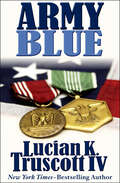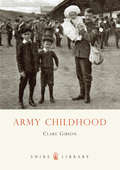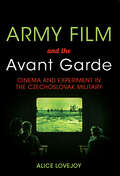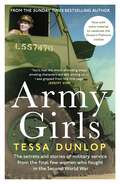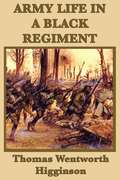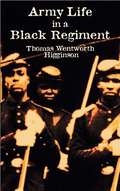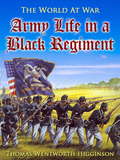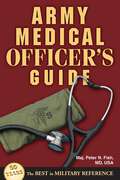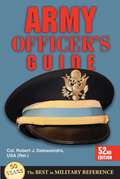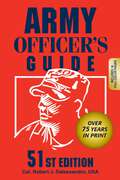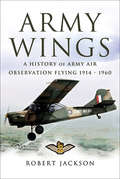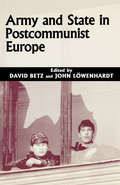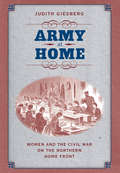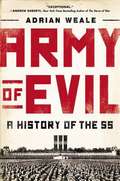- Table View
- List View
Army Blue
by Lucian K. Truscott IVFrom the bestselling author of Dress Gray. &“Part-war story, part-family saga . . . zeroes in on the men of the Blue family, three generations of soldiers&” (The Washington Post). In the eagerly anticipated follow-up to his first novel, Dress Gray, Truscott turns his attention to the Vietnam War and delivers a suspenseful, sprawling court-martial drama set in Saigon in 1969. At twenty-three, platoon leader Lt. Matthew Nelson Blue is the youngest member of an army family; his father is a colonel and his grandfather a profane, cantankerous retired general. Shortly after one of his men is killed by friendly fire while on routine patrol, Blue is arrested and charged with desertion in the face of the enemy. Arriving in Vietnam, his father and grandfather end their long estrangement and join forces to clear the young soldier&’s name. Truscott&’s plot offers less than initially meets the eye; the nature of the conspiracy and cover-up that nearly destroy Blue is fairly easy to predict, as is the disillusionment about Vietnam that eventually befalls his seniors. The author&’s intimate portrayal of the texture of army life gives his narrative a more deeply felt sense of anger and regret than others in its genre, and makes its final revelations more powerful than they might otherwise have been.
Army Childhood
by Clare GibsonAn army childhood is a peripatetic childhood. Taking the Napoleonic Wars as its starting point, Army Childhood sheds light on such crucial aspects of the army-child experience as the places that the children of British Army soldiers have called home, and on how they have been transported, housed, cared for, educated and entertained after the army assumed responsibility for their welfare. This informative and evocatively illustrated book will appeal to those interested in British military history's social side, and to those seeking to understand what life was like for an erstwhile army-child ancestor. It is also essential reading for those who were once themselves 'barrack rats', 'pads' brats', or 'army brats', in whom it is guaranteed to arouse nostalgic memories.
Army Film and the Avant Garde: Cinema And Experiment In The Czechoslovak Military
by Alice Osborne LovejoyDuring the 1968 Prague Spring and the Soviet-led invasion and occupation that followed, Czechoslovakia's Army Film studio was responsible for some of the most politically subversive and aesthetically innovative films of the period. Although the studio is remembered primarily as a producer of propaganda and training films, some notable New Wave directors began their careers there, making films that considerably enrich the history of that movement. Alice Lovejoy examines the institutional and governmental roots of postwar Czechoslovak cinema and provides evidence that links the Army Film studio to Czechoslovakia's art cinema. By tracing the studio's unique institutional dimensions and production culture, Lovejoy explores the ways in which the "military avant-garde" engaged in dialogue with a range of global film practices and cultures. (The print version of the book includes a DVD featuring 16 short films produced by the Czechoslovak Ministry of Defense. The additional media files are not available on the eBook.)
Army Girls: The secrets and stories of military service from the final few women who fought in World War II
by Tessa DunlopArmy Girls is the intimate story of the final few women who served in World War II and are still alive to tell their tale. They were female soldiers in a war Britain wanted to fight without conscripting women. It was a vain hope, by December 1941 for the first time in British history women were called up and a generation of girls came of age in khaki, serving king and country. Barbara trained to drive army-style in giant trucks and Grace swapped her servant's pinafore for battledress and a steel hat, Martha turned down officer status for action on a gun-site and Olivia won the Croix de Guerre in France.Commemorating the 80th anniversary of conscription for women, Army Girls captures remarkable stories from the last surviving veterans who served in Britain's female army and brings to life a pivotal moment in British history. Precious memories and letters are entwined in a rich narrative that travels back in time and sheds new light on being young, female and at war.Uniquely this moving Second World War memoir is embedded in the present day. Written in the midst of a global pandemic, the parallels and paradoxes between two very different national crises are explored in a book that honours the women who fought on in extreme youth and now once more in great old age.
Army Girls: The secrets and stories of military service from the final few women who fought in World War II
by Tessa DunlopArmy Girls is the intimate story of the final few women who served in World War II and are still alive to tell their tale. They were female soldiers in a war Britain wanted to fight without conscripting women. It was a vain hope, by December 1941 for the first time in British history women were called up and a generation of girls came of age in khaki, serving king and country. Barbara trained to drive army-style in giant trucks and Grace swapped her servant's pinafore for battledress and a steel hat, Martha turned down officer status for action on a gun-site and Olivia won the Croix de Guerre in France.Commemorating the 80th anniversary of conscription for women, Army Girls captures remarkable stories from the last surviving veterans who served in Britain's female army and brings to life a pivotal moment in British history. Precious memories and letters are entwined in a rich narrative that travels back in time and sheds new light on being young, female and at war.Uniquely this moving Second World War memoir is embedded in the present day. Written in the midst of a global pandemic, the parallels and paradoxes between two very different national crises are explored in a book that honours the women who fought on in extreme youth and now once more in great old age.(P) 2021 Headline Publishing Group Ltd
Army Life in a Black Regiment
by Thomas Wentworth HigginsonThomas Wentworth Higginson, a Unitarian minister, was a fervent member of New England's abolitionist movement, an active participant in the Underground Railroad, and not only corresponded with John Brown before the ill-fated raid on Harper's Ferry, but was part of a group that supplied material aid to Brown. When the Civil War broke out, his reputation, enhanced by his impassioned articles about Denmark Vesey and Nat Turner in the Atlantic, made him the perfect candidate to head the first regiment of emancipated slaves, and in 1862, he was commissioned as a colonel for the troops training in the Sea Islands off the coast of the Carolinas. Army Life in a Black Regiment is Higginson's stirring account of his wartime experiences. Shaped by American Romanticism and imbued with Higginson's interest in both man and nature, the narrative ranges from detailed reports on daily life to a vivid description of the author's near escape from cannon fire to sketches that conjure up the beauty and mystery of the Sea Islands.
Army Life in a Black Regiment (Civil War)
by Thomas Wentworth Higginson"Army Life in a Black Regiment has some claim to be the best written narrative to come from the Union [side] during the Civil War. Higginson's picture of the battle which was the origin of "praise the Lord and pass the ammunition" and his reading of the Emancipation Proclamation to the black regiment are unsurpassed for eloquence." — historian Henry Steele CommagerOriginally a series of essays, this important volume was written by a Union colonel from New England, in charge of African-American troops training on the Sea Islands off the coast of the Carolinas. A lively and detailed wartime diary, the book offers a refreshing portrait of life in the Union Army from an officer's point of view, recording opinions of other commanders and capturing the raw humor that develops among the men in combat. Higginson's descriptions of the soldiers, routines of camp life, and southern landscapes are unforgettable, as is the account of his near escape from a cannon ball. An unusual historical document intended to introduce new generations of readers to an American past that should not be forgotten, Army Life in a Black Regiment will be invaluable to students of Black History and the American Civil War.
Army Life in a Black Regiment (The World At War)
by Thomas Wentworth HigginsonThomas Wentworth Higginson (December 22, 1823 – May 9, 1911) was an American Unitarian minister, author, abolitionist, and soldier. He was active in the American Abolitionism movement during the 1840s and 1850s, identifying himself with disunion and militant abolitionism. He was a member of the Secret Six who supported John Brown. During the Civil War, he served as colonel of the 1st South Carolina Volunteers, the first federally authorised black regiment, from 1862–1864. Following the war, Higginson devoted much of the rest of his life to fighting for the rights of freed slaves, women and other disfranchised peoples. (Excerpt from Wikipedia)
Army Life in a Black Regiment and Other Writings
by Thomas Wentworth HigginsonA stirring account of wartime experiences from the leader of the first regiment of emancipated slavesThomas Wentworth Higginson, a Unitarian minister, was a fervent member of New England's abolitionist movement, an active participant in the Underground Railroad, and part of a group that supplied material aid to John Brown before his ill-fated raid on Harpers Ferry. When the Civil War broke out, Higginson was commissioned as a colonel of the black troops training in the Sea Islands off the coast of the Carolinas. Shaped by American Romanticism and imbued with Higginson's interest in both man and nature, Army Life in a Black Regiment ranges from detailed reports on daily life to a vivid description of the author's near escape from cannon fire, to sketches that conjure up the beauty and mystery of the Sea Islands. This edition of Army Life features as well a selection of Higginson's essays, including 'Nat Turner's Insurrection' and 'Emily Dickinson's Letters. ''Has some claim to be the best written narrative to come from the Union during the Civil War. '- Henry Steele CommagerIntroduction and Notes by R. D. MADISON
Army Medical Officer's Guide
by Peter N. FishGuide to the duties, customs, organization, administration, resources, and benefits for medical officers in the U.S. Army.
Army Nurse Corps Voices from the Vietnam War: Eight Women, One War (Palgrave Studies in Oral History)
by Janet D. TannerThis book provides an oral history of women who served in the U.S. Army Nurse Corps during the Vietnam War. It follows the trajectory of eight women’s lives from their decision to become nurses, to surgical and evacuation hospitals in Vietnam, and then home to face the consequences of war on their personal and professional lives. It documents their lived experience in Vietnam and explores the memories and personal stories of nurses who treated injured American soldiers, Vietnamese civilians, and the enemy. Their voices reveal the physical and emotional challenges, trauma, contradictions, and lingering effects of war on their lives. Women in the U.S. Army in Vietnam feared the enemy but also sexual violence and harassment: the experiences this book documents also shed light on the extent of historical sexual abuse in the military.
Army Officer's Guide
by Robert J. Dalessandro David H. Huntoon• Practical advice on Army leadership and command• Fully updated with the latest information for officers of all ranks, branches, and components• Uniforms and insignia, duties and responsibilities, privileges and restrictions, courtesy and customs, posts and organizations, regulations and references• Color images of medals and badges
Army Officer's Guide
by Robert J. DalessandroPractical advice on leadership and officership. Up-to-date information on pay, uniforms, and more.
Army Officer's Guide
by Usa Ltc Eric M. HiuThe Army Officer&’s Guide is the crown jewel of Stackpole&’s military reference line. First published in 1930, this guide has been continuously revised since then and has become the gold-standard reference for the U.S. Army&’s officer corps, especially the new second lieutenants commissioned into the army out of West Point and ROTC programs.This edition has been thoroughly revised and updated with the latest information on leadership, training, military justice, promotions, benefits, counseling soldiers, physical fitness, regulations, and much more—everything the officer needs to know in order to do his job well, to advance his career, to navigate the military, and to guide his soldiers on and off the battlefield.Topics includeHow to train, lead, and counsel troops effectivelyTips on how to move along your career as an NCO by continuing education, training, and professional developmentInformation about all the regulations NCOs need to be aware of in carrying out their jobsAnd much, much more . . .Stackpole has been guiding military officers and soldiers for more than 80 years. Our guides still offer the best advice in the business—better than any other book, better than the internet.
Army Rangers (Special Forces: Protecting, Building, Te)
by C. F. EarlThe Rangers are some of the best-trained and most skilled soldiers in the Army. Their motto--Rangers lead the way!--is not just a slogan; in many of the modern conflicts in which the U.S. military has been involved, the Rangers have been among the first soldiers on the ground. In both Iraq and Afghanistan, Rangers carry out raid, ambush, and rescue missions, as well as many other kinds of operations. Army Rangers gives readers a view into the world of the highly skilled Seventy-Fifth Ranger Regiment, today's Rangers, as well as a look at the history of the unit. Since the Revolutionary War, Ranger tactics and standards have been some of the most effective in the entire military. The book also includes information about: * The tough training courses that all Rangers must endure. * What kinds of weapons the Rangers use today and throughout history. * How the modern Rangers were organized and put into action around the world.
Army Special Forces Training For The Global War On Terror
by Major Daniel C. MollWith USSOCOM assuming the role as supported command in the Global War on Terror, Army Special Forces will no doubt to play a primary role in that effort. The unspoken assumption seems to be that America's new, unconventional foe will best be combated with America's own unconventional warriors. It is unclear, however, if a force raised to conduct behind-the-lines operations against a large conventional enemy will remain the force of choice against al-Qaida and similar threats. This thesis' central research question is: Is US Army Special Forces adequately prepared, and trained to fight the Global War on Terror? This thesis examines the contemporary operating environment, the threat represented by al-Qaida, and whether it represents a traditional terrorist threat or a new, transnational insurgency. A review of both types of organization over the last century indicates that al-Qaida is, at this stage, merely a terrorist organization, and not an insurgency. However, al-Qaida sprang from a region that is ripe for insurgency should the terrorists choose to become more than what they currently are. Combating the threat posed by al-Qaida, then, seems to require both an aggressive counter-terrorist campaign and a simultaneous pre-emptive counter-insurgency. A review of current training indicates that Special Forces appears well prepared for both efforts with one glaring deficiency: foreign language proficiency.
Army Spouses: Military Families during the Global War on Terror
by Morten G. EnderDistilled from nearly two hundred interviews, conducted from the 2003 invasion of Iraq on, Army Spouses marshals an incredible breadth of individual experiences, range of voices, insider access, and theoretical expertise to tell the story of US Army husbands and wives and their families during wartime in this century.Morten Ender offers the first contemporary study of the emotional cycle of deployment and its impact on military families in the post-9/11 world. Military spouses, as he shows, operate both near and far from the front lines, serving on the home front to support combat service in the so-called Global War on Terror that has intimately bound together soldiers, families, the military institution, the state, and society. He paints a vivid picture of army spouses’ range of responses to deployment separations that illuminates the deep sacrifices that soldiers, veterans, and their families have made over the past twenty years.
Army Wings: A History of Army Air Observation Flying, 1914–1960
by Robert JacksonThis is the fascinating story of army fixed-wing cooperation units who were made up of specially trained volunteer army personnel. These men were trained to fly, to reconnoiter across the front line in search of enemy forces and then guide artillery gunners onto the target.From its earliest days in World War I, small low-flying aircraft have flown unarmed into combat and relayed vital information to aid accurate fall of shot and to advise front-line ground troops of enemy strength and position. They were frequently attacked by fighter aircraft and had to avoid ground-fire, often flying below treetop height. They relied purely on flying skill to outwit the enemy and yet little is known of these unsung heroes of many wars. This book redresses the balance.
Army and Nation: The Military and Indian Democracy since Independence
by Steven I. WilkinsonSteven I. Wilkinson explores how India has succeeded in keeping the military out of politics, when so many other countries have failed. He uncovers the command and control strategies, the careful ethnic balancing, and the political, foreign policy, and strategic decisions that have made the army safe for Indian democracy.
Army and Society in Ptolemaic Egypt
by Christelle Fischer-BovetThis is the only substantial and up-to-date reference work on the Ptolemaic army. Employing Greek and Egyptian papyri and inscriptions, and building on approaches developed in state-formation theory, it offers a coherent account of how the changing structures of the army in Egypt after Alexander's conquest led to the development of an ethnically more integrated society. A new tripartite division of Ptolemaic history challenges the idea of gradual decline, and emphasizes the reshaping of military structures that took place between c. 220 and c. 160 BC in response to changes in the nature of warfare, mobilization and demobilization, and financial constraints. An investigation of the socio-economic role played by soldiers permits a reassessment of the cleruchic system and shows how soldiers' associations generated interethnic group solidarity. By integrating Egyptian evidence, Christelle Fischer-Bovet also demonstrates that the connection between the army and local temples offered new ways for Greeks and Egyptians to interact.
Army and State in Postcommunist Europe
by David Betz John LöwenhardtThis study explores the complex military issues that are raised by the transition to post-communist rule with particular reference to Russia, Ukraine, Bulgaria, and the new members of NATO. All faced similar problems yet their responses, it emerges, were surprisingly diverse.
Army at Home: Women and the Civil War on the Northern Home Front
by Judith Ann GiesbergIntroducing readers to women whose Civil War experiences have long been ignored, Judith Giesberg examines the lives of working-class women in the North, for whom the home front was a battlefield of its own. Black and white working-class women managed farms that had been left without a male head of household, worked in munitions factories, made uniforms, and located and cared for injured or dead soldiers. As they became more active in their new roles, they became visible as political actors, writing letters, signing petitions, moving (or refusing to move) from their homes, and confronting civilian and military officials. At the heart of the book are stories of women who fought the draft in New York and Pennsylvania, protested segregated streetcars in San Francisco and Philadelphia, and demanded a living wage in the needle trades and safer conditions at the Federal arsenals where they labored. Giesberg challenges readers to think about women and children who were caught up in the military conflict but nonetheless refused to become its collateral damage. She offers a dramatic reinterpretation of how America's Civil War reshaped the lived experience of race and gender and brought swift and lasting changes to working-class family life.
Army of Charles II
by John ChildsFirst published in 2006. Routledge is an imprint of Taylor & Francis, an informa company.
Army of Empire: The Untold Story of the Indian Army in World War I
by George Morton-JackDrawing on untapped new sources, the first global history of the Indian Expeditionary Forces in World War IWhile their story is almost always overlooked, the 1.5 million Indian soldiers who served the British Empire in World War I played a crucial role in the eventual Allied victory. Despite their sacrifices, Indian troops received mixed reactions from their allies and their enemies alike-some were treated as liberating heroes, some as mercenaries and conquerors themselves, and all as racial inferiors and a threat to white supremacy. Yet even as they fought as imperial troops under the British flag, their broadened horizons fired in them new hopes of racial equality and freedom on the path to Indian independence. Drawing on freshly uncovered interviews with members of the Indian Army in Iraq and elsewhere, historian George Morton-Jack paints a deeply human story of courage, colonization, and racism, and finally gives these men their rightful place in history.
Army of Evil: A History of the SS
by Adrian WealeIn Nazi Germany, they were called the Schutzstaffel. The world would know them as the dreaded SS—the most loyal and ruthless enforcers of the Third Reich… It began as a small squad of political thugs. Yet by the end of 1935, the SS had taken control of all police and internal security duties in Germany—ranging from local village “gendarmes” all they way up to the secret political police and the Gestapo. And by 1944 the militarized Waffen SS had more than eight hundred thousand men serving in the field, even rivaling Germany’s regular armed forces, the Wehrmacht. In Army of Evil: A History of the SS, author Adrian Weale delves into materials not previously available, including recently released intelligence files, the most up-to-date research and rare and never-before-published photographs. Going beyond the myths and characterizations, this comprehensive account reveals the reality of the SS as a cadre of unwavering political fanatics and power-seeking opportunists who slavishly followed an ideology that disdained traditional morality, and were prepared to implement it to the utmost, murderous extreme that ultimately resulted in the Holocaust. This is a definitive historical narrative of the birth, legacy, and ultimate demise of one of the most feared political and military organizations ever known, and those twisted, cruel men who were responsible for one of the most appalling crimes against humanity in all history. .
